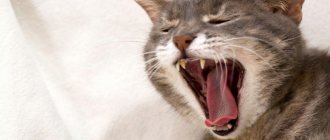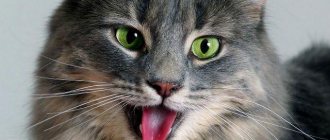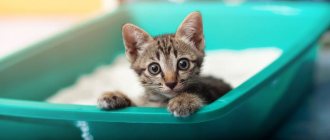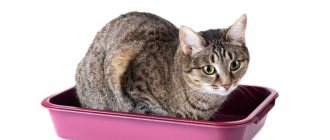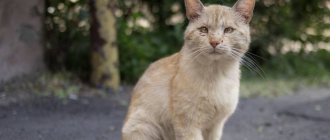Coughing is a protective reaction of the cat’s body from foreign objects that enter the respiratory tract, esophagus or stomach. Coughing can also be caused by hairballs in the stomach, inflammatory processes in the respiratory system, attacks of allergies or bronchial asthma.
If the owner notices that the cat is choking and coughing, as if it has choked, immediate measures must be taken to save the animal from suffocation. Let's find out why a cough occurs and how to independently help your pet before the veterinarian arrives.
Respiratory diseases
A common cold can easily provoke coughing, sneezing, swelling of the mucous membranes, and discharge of pus from the nasal passages and eyes. During this period, it is difficult for the pet to swallow, which is why he stops eating and even drinking. Inflamed airways, fortunately, are easy to treat.
Read also: Do-it-yourself warm hood
The disease is eliminated with the help of antiviral, antibacterial medications, as well as expectorants or antitussives, which are prescribed depending on the type of cough. To restore and subsequently strengthen the animal’s immunity, the veterinarian prescribes a vitamin complex. As a preventive measure , you should take your cat for vaccination , which will reduce the risk of a serious disease.
Treatment
First of all, we would like to remind you that cough therapy is individual and should be selected individually by the attending physician. It’s one thing to have a kitten that can’t cough up phlegm, and another thing to have an old cat with a whole bunch of illnesses. Each case requires an individual approach. Any treatment must be prescribed by a doctor. However, the owner must protect his animal from drafts and strong winds.
In case of severe cough , it is best to call a veterinarian at home. This will help avoid unnecessary risks and complications, since it is unlikely that it will be possible to completely protect the animal from exposure to cold. Also, in the veterinary center itself there may be sick and infected animals. This, in turn, is also an unnecessary and stupid risk that will affect your health. Depending on the diagnosis, adequate treatment is prescribed. Also, modern pharmacology offers many cough medications, but not all human medications are suitable for treating a constantly coughing cat. The most prescribed antibiotic is amoxiclav. It should be remembered that coughing is also a signal of an extremely weakened immune system in a cat.
If a cat is coughing and wheezing, what tests do a veterinarian need?
After a visual examination, you sit tensely in the doctor’s office and wait for the results. And the doctor suggests additional research
. For example, the doctor may prescribe fluorography, x-ray of the lungs, possibly an ultrasound. Of course, you will need a classic set of tests - urine, blood and feces. A severe cough should make your doctor consider prescribing antibiotics and other treatments.
However, if your lactating bitch or pregnant animal , we recommend that you be more attentive to treatment. Many of the modern antibiotics are simply dangerous for cats to take due to the possible risk of miscarriage or bleeding. Most doctors, for mild symptoms, recommend giving natural medications , for example, herbal solutions, which will need to be poured into the animal’s mouth with a syringe without a needle. Research in the form of tests is taken in the morning, on an empty stomach. This is necessary so that the parameters in the cat’s body do not change.
How to choose a veterinary center to treat an animal
If your cat starts coughing, and the cough itself becomes prolonged and frequent, we recommend that you consult a veterinarian without delay. As a rule, experienced owners already have a veterinarian’s phone number to whom they can turn for help at any time. But what to do if this is your first cat or animal in general? Of course, call the veterinarian.
The most experienced veterinarians work here around the clock and will be able to answer any question you ask them. It is possible that an in-person examination of the pet will be required to complete the picture. Don't refuse. This is the only way to make a correct diagnosis and establish the true cause of a cat’s continuous cough. A cough of unknown etiology is one of the most common reasons for visiting a doctor.
In addition to qualified personnel, our medical center has the most modern equipment for both X-ray and ultrasound. The laboratory is also equipped with the latest technology.
Benefits of in-home veterinary care
Many owners prefer to personally take their pet to a veterinary center for first aid. However, there are situations in life when it is not possible to visit a doctor yourself. For such cases, we have a very convenient service - veterinary care at home. Within 40 minutes after you leave your request, any of our highly specialized specialists will come to you. So what can we do at home?
- Our range of veterinary services is very diverse. Our specialists can:
- Take blood for analysis (both classical and biochemistry)
- Provide the necessary assistance
- Take an x-ray if necessary
- For the most severe cases we have ultrasound
- If necessary, we can transport your four-legged friend to the hospital.
- We can also select adequate treatment that will help the animal recover in the shortest possible time and again delight the owner with playfulness.
Only the most modern equipment and the gentle hands of veterinarians and laboratory technicians can save another little life. A huge number of branches will allow you to choose the medical center closest to your place of residence. However, there are places from where it is difficult to get to our center. In this case, there is a convenient service for providing veterinary care at home. So what are our advantages?
- Mobility
- Avoiding unnecessary stress that may affect test results.
- Reducing the risk of reinfection
- The owner will be able to significantly save his time and have complete control over the process
- The animal will be more comfortable with the necessary manipulations.
As you can see, there are many benefits to in-home veterinary care. Many busy owners have already appreciated the benefits of home care, because it helps to collect blood and examine the animal calmly and without stress.
Main symptoms
It is very easy to identify a cough in your pet. The cat unnaturally stretches its neck forward, tilts its head, and opens its mouth. He coughs with his mouth open, making characteristic sounds. From the outside it may seem that your four-legged pet is vomiting. Most often, vomit is released along with the cough.
If the cough is isolated, then this should not be a cause for concern. With the help of a reflex, the animal simply tries to relieve irritation on its own. It’s another matter if the cough is prolonged, accompanied by other signs, such as snoring and wheezing.
It should be noted that a cat may snore from time to time, for example, when there is a lack of water. She may sometimes experience wheezing - when the animal swallows too large a portion of food.
However, if the above symptoms are presented together and are accompanied by changes in behavior (refusal to eat, restlessness, decreased activity, weight loss, exhaustion, etc.), this is already a reason to visit a veterinary hospital.
How to understand that a cat is not just coughing, but choking
If a cat coughs, wheezes and at the same time stretches out, pressing her whole body to the floor, then in 99% of cases this indicates that a foreign object has entered the esophagus or respiratory tract. When a cat coughs as if he is choking, you should not do anything on your own. You should immediately take your pet to the clinic.
Sometimes the cat gags and coughs, as if he wants to vomit, but attempts remain to no avail. This may indicate that the pet is unable to get rid of a large trichobezoar in the stomach on its own.
If the cat coughed, as if she was choking, but quickly came to her senses, then there is no reason to worry, as she could simply have choked.
Helminths
Worms that appear in the body irritate the mucous membrane, causing a cough. This is often accompanied by weight loss, vomiting and dandruff. To combat them, the pet is given antihelminthic medications. In severe cases, they are given again a week after the first dose. Delay can lead to problems with the liver, kidneys and even death.
Trichobezoars, coughing up hair
Cats groom themselves by licking their fur coat with their tongue. That, in turn, can enter the digestive organs. The lumps formed there provoke coughing. It doesn't pose a threat. A paste that dissolves lumps or special food will help.
To measure the temperature
Throat injuries
They also irritate the larynx. Sores and ulcers can be a sign of chlamydia, which people can become infected with.
Heart diseases
Cardiac cough gradually intensifies and is accompanied by lethargy, shortness of breath, and heavy breathing. A cardiogram will confirm this version.
Respiratory diseases
These include viral, bacterial, and fungal infections. Immediately the cough is dry and loud. On the second day, sputum separates and he becomes deaf. In addition, nasal discharge, rotting of the eyes, weakness, and increased body temperature appear.
What to pay attention to
A cat's cough, the causes and treatment of which can be different, worries all owners who are faced with unfamiliar and frightening symptoms. Of course, it is better to immediately contact a veterinarian. But if this is not possible, you can try to understand what the problem is. Sometimes a cat's cough is completely harmless and goes away on its own. In other cases, specialist help will be required.
You can understand why a cat coughs and how to treat it in each specific case by assessing the general condition of the animal and specifying the presence or absence of other characteristic signs. It is also necessary to record the number and duration of attacks, and understand what time of day they occur.
Sneezing and coughing indicate that something is irritating the cat's mucous membranes. The reaction to viruses, parasites or a foreign body can be almost the same. The animal rubs its muzzle with its paw, tilts its head, stretches its neck, trying to get rid of unpleasant sensations. Sneezing is most often associated with a problem in the nose area, while coughing indicates that the irritant has reached the mucous membrane of the throat.
Some owners are scared by the sound a cat makes. Due to the specific structure of the throat, palate and tongue, the animal makes expectoration movements, opening its mouth wide and intensely sticking out its tongue. The process is accompanied by heavy, hoarse breathing, as if the cat is suffocating. Usually it is not possible to clear your throat right away; sometimes the process ends with vomiting or copious amounts of saliva.
The causes of cough in a cat can be varied. Most often they become:
- foreign body in the mouth, nose or throat;
- a ball of hair that the animal could not swallow;
- eating food too greedily;
- cold.
Coughing immediately after eating should not cause panic in the owner. Probably a piece of food has stuck to the roof of your mouth and is irritating your throat. A choking pet makes wheezing sounds and sticks out its tongue, trying to get rid of the problem. Convulsive coughing ends with vomiting, after which the pet eats the vomited food and calms down. This behavior is typical for representatives of some breeds, as well as for cats that swallow food too greedily.
Some cats cough frequently, while others make almost no such noise. If this is a one-time phenomenon, after coughing the cat calms down and behaves as usual. But sometimes the cat cannot get rid of the problem on its own; the cough gets worse and is accompanied by other unpleasant symptoms. In this case, you should be vigilant, carefully observe the animal and try to help it.
Types of cough
Just like in humans, a cat’s cough is characterized by several criteria, thus being divided into types:
By duration:
- Chronic – lasts for months;
- acute – lasts several days.
By the nature of the discharge:
- wet;
- dry.
By volume:
- muted;
- weak;
- voiced.
By intensity:
- easy;
- hysterical, leading to vomiting.
By time of day:
- morning;
- evening.
By season:
- spring;
- autumn, etc.
When you observe your pet's cough, try to determine its type based on these parameters, so that you can then provide the doctor with a complete picture of the disease. Also pay attention to the time of day at which the cough peaks.
Kinds
Veterinary experts distinguish the following categories of cough in couch potatoes:
- Duration: acute or chronic . Acute cough is characterized by sudden onset and duration from 1 to 7 days. Chronic can drag on for a long time - up to several months.
- By sound - ringing or muffled.
- Depending on the type of discharge (or lack thereof) – dry or wet. A dry cough is characterized by a hacking sound. When wet, the owner may notice wheezing and gurgling. The cough may be accompanied by the release of mucus, sputum, and blood.
- By time of appearance: morning, afternoon, evening, night.
- By strength: weak, noted as coughing, and strong , with the cat coughing as if he wants to vomit.
The owner of the animal should pay attention to these features.
Detailed information about the type of cough will allow the veterinarian to correctly suggest the cause, prescribe diagnostic procedures and determine treatment. In addition to the above categories, veterinary specialists also note the respiratory and cardiac forms. When the cough is respiratory, it is usually loud.
At the first stages of the inflammatory process, no discharge is observed in the respiratory organs; accompanying symptoms (runny nose, sneezing, fever) do not appear immediately.
A cardiac or cardiac cough is the cause of pathology in the functioning of the heart and is accompanied by a dull sound. No mucus or sputum secretion is observed. The reason for such a reflex act is either a pathological thickening of the walls of the heart, or the accumulation of exudate in the lungs due to circulatory disorders in the pulmonary circle.
We recommend reading about why a cat's eyes are watery. You will learn about the causes of lacrimation in cats, treatment, and proper eye hygiene. And here is more information about the treatment of discharge from the eyes of a cat.
Treatment of cough at home
Therapy is determined by the complexity of the pathological process and is aimed at eliminating it:
- For invasive cough, antiparasitic procedures are prescribed, and in the future it is recommended to regularly prevent the disease.
- Attacks due to cardiac problems are eliminated by comprehensive treatment of the cardiovascular system and general cough suppressants.
- The specificity of antiviral and antibacterial therapy is determined by the characteristics of the cough: expectorants are prescribed for dry coughs, and antitussives for wet coughs.
- Asthmatic attacks are stopped by hormonal and glucocorticosteroid, antiallergic drugs.
- Special creams and pastes improve the condition of trichobezoar They cover the surface of hairballs and facilitate their natural release.
- Cough from injuries to the respiratory organs and throat subsides as they heal. If internal organs are injured, the pet is given crushed food. For external wounds, treatment methods depend on the severity of the pathology. In serious situations, the wound is surgically sutured and antibacterial therapy is carried out.
Drug therapy for cough in cats
For symptomatic treatment of cough itself, the following is used:
- centrally acting antitussives - block the area of the brain responsible for coughing, thereby breaking the arc of the cough reflex. These drugs are rarely prescribed for intense dry cough that debilitates the animal. They are potent, and it is also necessary to take into account that coughing has a protective function, accelerating the evacuation of pathogens, toxins and inflammatory products from the respiratory tract, therefore, the cat needs it to speed up recovery. Not prescribed for wet cough;
- mucolytic (expectorant) agents - dilute sputum, increasing its quantity by increasing the fluid content; The cough becomes productive, which helps to quickly clear the airways. Mucolytics should be handled with caution and strictly adhere to the dosage prescribed by the doctor, and also avoid their combination in the treatment regimen, as this may result in a slowdown in the evacuation of an increased amount of sputum and the development of pneumonia.
Table: overview of medications used to treat cough in cats
| A drug | Compound | Operating principle | Price, rub |
| Bromhexine | Bromhexine | Increases the amount of sputum, facilitates its removal, slightly reduces the intensity of cough | from 20 |
| Codeine phosphate | Codeine phosphate | Refers to narcotic opiates. Blocks the cough center of the brain; can lead to lethargy, constipation, anorexia, vomiting, difficulty breathing and addiction, so it is rarely used. Used to treat intense dry cough. | Not commercially available, only by prescription from a veterinarian; the price is low |
| Potassium Iodide | Potassium iodide | After administration, it is secreted by the bronchial glands and thins mucus. Stimulates the activity of the ciliated epithelium of the respiratory tract, which promotes the removal of sputum | from 57 |
| Mukaltin | Marshmallow herb, polysaccharides | Increases the amount of sputum due to its dilution, facilitating its removal; reflexively stimulates cough activity | from 10 |
Herbal decoctions for treating coughs in cats
The use of herbal decoctions to facilitate the discharge of sputum when coughing is permissible in consultation with a veterinarian, in the absence of other mucolytics in the treatment regimen:
- infusion of plantain leaves: 1 tablespoon of dry plantain leaves is crushed, placed in a thermos and poured with a glass of boiling water. Leave for 6 hours; then cool and filter. Give the cat half a teaspoon 3 times a day;
- infusion of leaves and flowers of coltsfoot: pour 1 tablespoon of crushed flowers and leaves of coltsfoot with a glass of boiling water and heat for 15 minutes in a water bath with frequent stirring; cool and filter. Set 1.7 ml per kg of weight; The daily dose is divided into 2-3 doses per day.
Diagnostics
Having studied the external symptoms of cough, we proceed to diagnosis:
- conduct an external examination of the body, listen for wheezing and noises;
- evaluate cardiac activity;
- take blood for analysis;
- do an X-ray examination of the sternum;
- a culture of secretions or sputum is collected to identify the causative agent of inflammation;
- examine the affected organ for oncology (if suspected).
In clinics, it is possible to examine the entire animal’s body by different specialists and conduct an X-ray examination with a contrast agent.
Prevention
Experienced breeders and veterinarians recommend that owners take the following preventive measures:
- Keeping your pet in a clean and ventilated area. Regular wet cleaning, the use of air humidifiers, and the absence of tobacco smoke reduce the risk of developing a reflex cough in pets.
- Prevention of hypothermia - keep in a warm room, without drafts.
- Regular treatment of the animal against helminths. Excluding raw meat and fish from your pet’s diet.
- Vaccination against viral infections such as rhinotracheitis, calcivirosis, etc.
- Strengthening the pet's immunity: feeding with nutritious food, vitamin and mineral prophylaxis.
The owner of a furry couch potato should not ignore a cough. The cause of the reflex act can be serious diseases of the upper respiratory tract, lungs and even the heart. Under no circumstances should you self-medicate your pet. The effectiveness of treatment directly depends on correct and timely diagnosis.
Similar articles
- Bronchitis in cats: symptoms, how to treat chronic...
Dangerous bronchitis in cats: signs of presence, treatment and prevention. ... At the beginning of the development of the pathological process, the owner observes a dry cough. Read more - How to measure a cat's temperature: what is normal, how...
You will learn about the mechanism of cough development in cats, the causes of... If a high temperature is detected in a cat (hyperthermia), do not immediately panic. Read more
- The cat is sneezing: what should the owners do? | Why does a cat sneeze
In addition to this symptom, a sick cat has a runny nose, high fever, cough... Read more
- Pneumonia in cats: symptoms of pneumonia, how...
Cough. The inflammatory process is characterized by the accumulation of exudate in ... About the symptoms and treatment of pneumonia in cats, watch this video: Diagnosis. Read more
- How does an allergy to cats manifest in adults and children...
Cat fur itself is not an allergen and does not lead to the development of a pathological reaction in... Coughing and sore throat are often noted. Read more
Diagnosis of the condition
The multiplicity of causes that can cause cat cough makes it very difficult to diagnose cats. Therefore, the veterinary specialist consistently conducts a series of studies, including:
- collection of anamnestic data;
- inspection;
- palpation;
- percussion;
- auscultation;
- general and clinical blood test;
- radiography;
- coprogram for identifying intestinal helminth eggs.
If it is not immediately possible to determine the reason why the cat cannot cough, the veterinarian will prescribe additional laboratory and instrumental tests.
Note! Only large veterinary clinics can afford additional research, and the cost of these services is quite high. Therefore, it is advisable to carry them out more often for such high-pedigreed “expensive” cats as Sphynx, Maine Coon, Peterbald, Scottish Fold and others.
Specific additional studies that will help determine exactly why a cat is coughing with wheezing include:
- sputum analysis for the presence of viral agents and their identification;
- fluoroscopy of the esophagus using a contrast indicator;
- endoscopy of the upper respiratory tract and esophagus;
- bronchoalveolar lavage (performed under general anesthesia).
If the doctor suspects that the cat cannot cough due to the development of pathology of the cardiovascular system, the doctor will prescribe an ECG or ultrasound of the heart.
How to treat cat cough
If a cat is coughing, it can be treated at home only after being examined at a veterinary clinic, making an accurate diagnosis and prescribing appropriate therapy.
You should not self-administer cough suppressants before visiting a doctor, as this may change the clinical picture of the disease and make it difficult to determine the cause of the pathology.
Important! If the cat is coughing and wheezing, as if he is choking, then you should not take any independent action. It is better to quickly take your pet to the hospital or call a doctor at home. Delay can also be fatal when the cat wheezes, trying to burp, but only spits up saliva or foamy liquid.
If a cat coughs due to an infectious disease of viral etiology, the doctor prescribes:
- antibacterial drugs (Amoxisan, Sinulox, Tsiprovet) to prevent the development of secondary bacterial infections;
- mucolytic and expectorants (Bromhexine, licorice extract);
- immunomodulators (Cycloferon, Fosprenil, Maxidin);
- globulin Vitafel;
- intravenous injections of Ringer-Locke solution or saline with 5% glucose (to prevent dehydration when refusing food).
If the cough is accompanied by wheezing and the cat coughs while stretching its neck, then the cause may be pneumonia or another inflammatory process in the respiratory system. In this case, antibiotics are first prescribed. And to relieve coughing, the cat should be given antispasmodics, mucolytics and expectorants.
If a cat's cough is accompanied by vomiting, this often indicates helminthiasis. In this case, anthelmintic drugs are prescribed (Pyrantel, Prazicide, Drontal, Milbemax). Despite the fact that these medications are sold in pharmacies without a prescription, you should not use them yourself if your cat wheezes and tries to burp.
In case of severe infestation, an incorrectly selected dosage can lead to excessive activity of parasites and lead to suffocation. Illiterate actions by owners can also lead to intestinal rupture or excessive intoxication in small kittens.
If the reason that the cat is coughing and stretching its neck, as if choking, is trichobezoars, then the doctor will prescribe special pastes and gels to remove or dissolve hairballs in the stomach.
If a cat coughs and wheezes with its tongue hanging out, this may indicate an attack of bronchial asthma. You can quickly relieve an attack with:
- glucocorticosteroids (Hydrocortisone, Prednisolone, Dexamethasone, Fluocinolone);
- bronchodilators (Theophylline, Atropine);
- antibiotics (if there is a threat of infection by pathogenic bacteria).
Important! Self-administration of glucocorticosteroid and bronchodilator drugs to treat Sphynxes and other cats when they cough while stretching their necks can lead to overdose, complications and the development of side effects. Therefore, you should not put your pet’s life at risk; you must urgently take him to the clinic.
The reason that the cat is coughing, wheezing, as if he is choking, may be a heart attack, which develops in the cat as a result of a hidden pathology of the cardiovascular system. In this case, any independent treatment is unacceptable.
You should immediately call the clinic, call a veterinary specialist to your home and get a recommendation on the actions that need to be taken before his arrival.
Heart problems
Many people do not know what to do if a cat coughs and wheezes, for what reason this reflex occurs. A serious reason to see a doctor is the occurrence of heart problems. Most often, this disease occurs in old and overweight animals. At first, coughing rarely bothers the animal, but later it inevitably becomes more frequent.
The disease is diagnosed by tactile and visual examination. The pet's blood pressure is measured, electrocardiography and radiography are performed. Such a disease requires lifelong care for the animal and maintenance therapy. Treatment is prescribed by a veterinarian based on the research results obtained. Giving medications at your own discretion is strictly prohibited.
The cat must be provided with rest, proper nutrition and follow the doctor's instructions. For animals with this pathology, special dietary foods are sold in pharmacies.
How to help a cat who is choking
If, after eating fish or tubular bones, the cat sticks out its tongue, coughs, wheezes, or simply sits with its mouth slightly open, then there is a high probability that a sharp bone is stuck in its throat or esophagus.
If you have experience with animals, you can try to remove it yourself. But this can only be done if the bone is clearly visible in the oral cavity. To do this, you need to secure the cat. Then ask an assistant to hold the animal and try to open the pet's mouth wide.
The next step is to remove the bone using tweezers.
If the cat coughs, wheezes, or sticks out its tongue and makes wheezing sounds, but upon examination a foreign object cannot be detected, then the animal should be taken to the doctor immediately.
Types of cough depending on the cause
Cough has many varieties. To treat it, it is important to identify the irritant. Depending on the cause, different associated symptoms will be observed.
Allergic
Seasonality of attacks is typical for pollen allergies. An allergic reaction is accompanied by discolored discharge from the nose, redness of the eyes, or hair loss.
Allergens also include food, fillers, household chemicals, dust, tobacco and other irritants. Try eliminating the options listed and observe the reaction.
Asthmatic
Bronchial asthma is a chronic disease of the respiratory tract. It occurs with prolonged exposure to allergens in animals over 3 years of age.
Unlike allergies, asthma attacks occur progressively. At first, the cat coughs as if she was choking, and a week later she loses consciousness and faints due to lack of oxygen. Swelling of the mucous membrane blocks the glottis and prevents normal air circulation. Pathology can be suspected based on the following signs:
- dry cough lasting more than a week;
- gradual increase in attacks;
- the appearance of shortness of breath;
- no increase in temperature;
- blueness of mucous membranes;
- increased drowsiness.
If you notice any of these symptoms, contact your veterinarian. Delay in case of bronchial asthma is unacceptable, as it can result in the death of the animal.
Viral
Colds in cats caused by hypothermia are rare. Most often, the reason that a cat is coughing as if he is choking is due to a viral infection. When infected with viruses, the symptoms are supplemented by:
- loss of appetite or complete refusal to feed;
- wheezing and vomiting;
- increased body temperature;
- lethargy and apathy;
- the appearance of serous-purulent discharge from the eyes;
- runny nose and drooling;
- formation of ulcers in the oral cavity.
Possible diagnoses include calcivirosis and rhinotracheitis. When prolonged, they lead to pneumonia, numerous ulcers and blindness. Kittens under six months of age suffer the most severe diseases - among them the mortality rate from viruses is very high.
Infection with worms
If your pet cannot cough for a long time, check it for parasites. Lungworms easily penetrate the body of even couch potatoes. They get inside an animal when it eats contaminated food or an intermediate host (mouse, insect, bird).
Inside the host's body, the parasite travels the full route, moving through the bloodstream from the intestines directly to the lungs. When re-swallowed, the cough reflex causes the worms to rush back into the small intestine, where they develop into adults. There they lay eggs, and the cycle repeats again.
Helminthiases are accompanied by:
- lethargy and apathy;
- enlarged abdomen;
- the appearance of dull and tousled fur;
- blanching of mucous membranes;
- frequent vomiting, diarrhea, bloating or belching;
- dandruff formation;
- weight loss while maintaining appetite;
- the presence of mucus, blood or parasites in the stool.
If these symptoms are detected, it is recommended to immediately consult a veterinarian. Self-medication can lead to severe intoxication of the body and death of the animal.
Foreign object or coughing up fur
Sometimes a cat coughs, as if choking, after swallowing a foreign object. Using the cough reflex, she tries to remove the stuck body from the trachea and larynx. Foreign objects entering the respiratory tract occur when:
- chewing bones or toys;
- artificial feeding through a syringe;
- regurgitation and vomiting;
- hasty eating;
- forced intake of large medications in capsule or tablet form.
Swallowing sharp or large objects increases the likelihood of internal injuries. If the object is firmly lodged in the depths of the larynx, you will have to resort to surgical intervention. Otherwise, the cat may die from suffocation.
In addition to foreign objects, the cause may lie in trichobezoars, that is, hairballs. They accumulate in the stomach after licking. One part of the lumps comes out with feces, the other dissolves in gastric juice. If there is excessive accumulation of trichobezoars, they begin to irritate the gastric walls, activating the cough reflex. You can help the animal by feeding it herbs or a special paste - then the cat will vomit hair and the cough will stop.
Mechanism of cough development
A periodically occurring cough in a cat may indicate the development of inflammatory processes in the respiratory system, which require long-term treatment under the supervision of a veterinarian. It can also occur when trying to get rid of hairballs that accumulate in the animal’s stomach.
However, if the cat spontaneously begins to cough, wheeze, stretch out and press itself to the floor, this most often indicates ingestion or inhalation of small foreign objects. In this case, the animal must be quickly assisted or taken to the clinic without delay.
A cough is a strong, accelerated exhalation through the mouth, which occurs due to a sharp contraction of the muscles of the respiratory tract as a result of irritation of the receptors. In this way, the cat's respiratory tract is freed from mechanical substances that impede the movement of air along the airways.
The cough algorithm consists of the following stages:
- take a deep breath for no more than 2 seconds;
- reflex contraction of the smooth muscles of the larynx, which closes the glottis;
- increased tone of the bronchial muscles;
- sharp contraction of the abdominal muscles;
- opening of the glottis;
- a powerful exhalation that expels foreign agents.
Types and symptoms of cough in cats
The classification of cough in cats is described in detail in the table.
| Characteristics of cough | Degrees and types of cough manifestations |
| Force | slight cough; hacking cough |
| Form depending on duration | acute (less than 14 days); prolonged (from 14 to 45 days); chronic |
| Timbre | silent; voiced; deaf; hoarse; hoarse; barking |
| Presence of discharge | dry; wet |
| Character of sputum | serous; slimy; purulent; mixed with blood |
| Development time | constant; seasonal |
Symptoms that most often accompany coughing in cats include:
- discharge from the nasal cavity;
- vomit;
- wheezing.
The nature of the cough helps specialists make the correct diagnosis, identify the causes and prescribe appropriate treatment for a coughing cat.
How does cough manifest in cats?
Coughing itself is a necessary mechanism, since with its help the pet gets rid of particles that irritate the respiratory tract. Because of this, pus, blood, mucus, particles of dust, fur and even food can be coughed up in the process. Externally, the attack is slightly different from a similar symptom in humans, and therefore often frightens the owners.
A cough in cats manifests itself in the form of a sharp exhalation with a loud sound, since some of the cough receptors are located in the vocal cords.
Also, during an attack, a reflex muscle contraction occurs, which allows the irritating substances to be pushed out. Usually, during an attack, the cat strongly stretches its neck.
To make an accurate diagnosis, you need to observe the cat a little. A cough may be just a one-time occurrence that is not worth worrying about, but the constant occurrence of a symptom with varying characteristics is a reason to consult a doctor. During an attack it is worth noting:
- Its duration. For some animals, coughing is a constant symptom for months or even years.
- Period of manifestation. Sometimes irritation of the upper respiratory tract occurs at the same time or season.
- Discharges accompanying the process. Cats have both dry and wet coughs. In the latter case, it may even be accompanied by nausea.
- Power of attacks. Short and light coughs, as a rule, do not cause as much concern as a hacking cough. Discharge is mainly characteristic of powerful attacks.
- Sound. Coughing is caused by vibration of the vocal cords, but it is not always the same sound. A loud, sharp sound and a muffled, lingering sound are noted.
© shutterstock
After identifying all the signs of a symptom, we can talk about the possible causes of its occurrence. The types of coughs often change during illness, so it is necessary to monitor your pet's current condition.
Symptoms and diagnosis
The list of symptoms is usually typical and includes the following manifestations:
- Cough - dry or wet, with sputum.
- Difficulty breathing, accompanied by extraneous sounds.
- Shortness of breath even after minor physical exertion.
- Decreased appetite.
- Lethargy, changes in behavior.
- Excessive salivation, irritation of mucous membranes.
If coughing or wheezing is caused by an infectious disease, then signs of an inflammatory process such as fever are added to the symptoms.
Diagnosis is made based on an assessment of symptoms. Its main task is to determine the cause of wheezing and coughing for further relief. After collecting anamnesis and examining the animal, the veterinarian may prescribe:
- Blood analysis.
- Stool analysis to detect lungworms.
- Analysis of tracheal swabs.
- Chest X-ray.
If it is difficult to make a diagnosis, other examinations may be performed.
Doctor MOM® for the treatment of cough and sore throat
In the complex treatment of cough and sore throat, the use of herbal medicines from the Doctor MOM® line - syrup and herbal cough lozenges - is indicated. Thanks to the unique1 “FITO BRONHO formula”2 based on medicinal plant extracts, the products in the Doctor MOM® line have a complex effect, helping to both relieve unpleasant symptoms and eliminate their cause - inflammation.
The main actions of Doctor MOM® syrup and herbal cough lozenges are:
- Eliminating the cause of cough – inflammation;
- Removing infection from the body3;
- Combating unproductive and unproductive cough.
Main reasons
You can understand the reason why a cat wheezes and coughs, and whether this symptom should be treated or not, if you correctly assess the condition of the pet. It is necessary to pay attention to the presence or absence of accompanying symptoms, record the duration of attacks and the time of day at which they most often occur.
Cough is a companion to many diseases. In cats, as a rule, it does not act as an independent disease, but manifests itself as a symptom of some ailment:
- If you had to observe how an animal stretches its neck, coughs heavily and at the same time breathes heavily, then we can talk about asthma. Most often it affects animals older than two years. At first the attacks are rare, but later they become more frequent and intensify.
- Similar symptoms can develop in case of an allergic reaction to dust or odors of human food. In this case, the pet sneezes and coughs a lot. You should not self-medicate. It is better to show the furry animal to a veterinarian, who will prescribe the necessary treatment.
- Pinworms and other worms, which almost every animal has, can cause painful coughing and wheezing.
- A reflex spasm can also be triggered by the entry of a foreign object into the respiratory tract. This happens when the pet's owner allows him to eat food with bones or play with small toys that the pet may accidentally swallow. In such a situation, you cannot do without urgent contact with a specialist, since an independent attempt to remove a foreign object can harm the cat.
- The kitten may choke on its own fur in its throat. This is completely harmless; subsequently, the pet will vomit the lump on its own. A similar phenomenon is most often observed in representatives of long-haired breeds.
- Pneumonia is difficult for pets and causes severe coughing. The animal's body temperature rises and vital energy noticeably decreases. Pneumonia usually results from hypothermia.
- In case of cardiovascular diseases, wheezing in the chest is observed, and treatment at home is contraindicated.
- Oncology in the respiratory tract provokes severe coughing attacks.
- Acute respiratory illness, viral or bacterial infection of the respiratory tract also causes this reflex.
There are also a large number of reasons that provoke coughing. For an accurate diagnosis, you need to contact a veterinarian.

